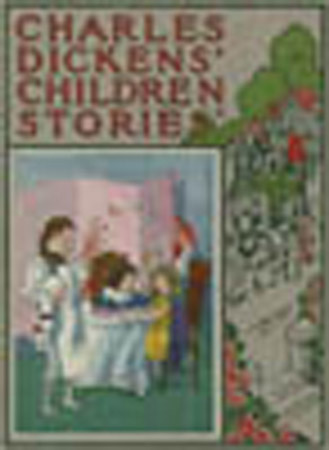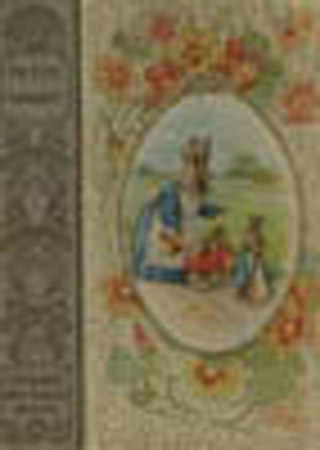| In 1904 Altemus published
the first six books of a series of fairy tale books that
would prove to be an extremely popular and a very long
running series.
“An entirely new series of books for
children, especially adapted for Christmas or birthday
gifts” Altemus Catalogue 1904-1905.
“To those parents of little children
in the very morning of life, Altemus’ Wee Books come
as a positive blessing. These stories deal with
familiar animals, fairies and simple incidents, and
are illustrated in colors”. Altemus catalogue 1925.
These books had three different
formats. The first is the scarcest while the third is
quite common. As time went on, Altemus discontinued
most of its other fairy tale books to concentrate on
this group of books. New books were added yearly and
spin-off series such as the Peter Rabbit Series and
Little Black Sambo books were published. Finally near
the end of the run all the books were combined into
one large umbrella listing. (Later, after Henry
Altemus went out of business, Platt and Munk reprinted
many of the books.)
FORMATS
Format I:
The first format is the scarcest and contains the most
valuable book (The Tale of Peter Rabbit) in the
series. In 1904 the first six books could be purchased
either separately or as one of three boxed sets of two
books each. The first American pirated edition of
Peter Rabbit was part of this initial set. This format
had a run of less than a year and was quickly replaced
by the second format. Of interest is the frequent
claim of a Peter Rabbit first in the second or third
format style. The confusion exists because all three
formats list 1904 as the copyright date and formats 2
and 3 actually list that date (1904) on the title
page.
The books are half vellum with a typical (of the era),
line drawn decoration in gold gilt with the name of
the title and the series also in gold gilt on the left
of the front cover. On the right there is an oval
within which is a book appropriate multicolored
pictorial picture. Outside of the oval is a floral
decoration. Decorated orange line drawn endpapers
which picture active children are noted in the front
and rear of the book. The books are 5.5 x 4.25. All of
the books can be seen at: http://henryaltemus.com/series/series185.htm
The boxed sets are as follows. Nursery Tales with
Nursery Rhymes, Three Little Pigs with The Robber
Kitten and The Tale of Peter Rabbit with The Foolish
Fox. These sets are clearly the rarest of any Altemus
boxed sets.
Format II:
The second format is much more commonly seen than the
first and was published from 1904 until 1917. It
consists of the first six books of the series.
Although the title pages and basic text of the books
were unchanged between this format and format I, the
book covers are different. Now the cloth covers have
multicolored line drawn illustrations which are book
appropriate. The books are still the same size
however.
During the years of this format's publication run the
books went through several changes. The earlier books
had green covers (except for the Three Little Pigs
book which was orange or beige and had the pigs
holding a white bag with red dots as opposed to the
later books which had bags that were yellow with red
dots) and had the same orange line drawn picture
endpapers that were present in format I. The green
covered books were replaced between 1908 and 1912 with
beige colored book covers which were otherwise
identical to the green books. This cover color was
present until 1917. It was during the beige run that
the names of two of the books changed. Nursery Tales
and Nursery Rhymes became Mother Goose Nursery Tales
and Mother Goose Nursery Rhymes in 1916.
The third cover in this format is blue-grey with a
red-orange spine. The cover pictures, except for the
colors, are unchanged. This cover is seen with some
1917 books.
Except
for
some very early beige books, the beige books as well
as the blue-grey covered books have blank endpapers.
The books published after 1916 may advertise the
Mother Goose Series (although some books have no ads).
Finally as noted above, the name changed books are
later. Dust jackets in this format prior to 1914 are
of the brown uncoated type. After 1915 the jackets are
white and coated and match the book cover.
Format III:
"To those parents of little children in the very
morning of life, Altemus Wee Books come as a positive
blessing". Altemus Catalogue 1925-1926.
The third format with the familiar book appropriate
appliqué is the most common and best recognized Wee
Book. This format began in 1917 and was published into
the 1930s without a significant change. While some
books were being added to the Wee book's list, others
were being deleted so that they could be the first
books of other Wee Books' Series such as the Peter
Rabbit Series, Little Black Sambo Series, Little
Sallie Mandy Series, Wish Fairy Series and the Wee
Folks Bible Stories Series. During this time period
the Wee Folk's Cinderella Series and the Little Bunnie
Bunniekin Series were also published. Although the
contemporaneous book advertisements distinguished
these latter series as separate from the Wee Books for
Wee Folks Series, many non-Altemus book advertisements
lumped them all together by the late 1920s. The
various additions and deletions over the life of the
series are outlined in the bibliography section of
this book. The individual books appear the same
regardless of which series they were included in at
the time.
The
books
are unchanged in size from previous formats. They are
grey with a book appropriate multicolored pictorial
appliqué (3.5 x 2.5) which is surrounded by a simple
line drawn picture. These line drawn pictures very
from series to series. In addition there are some that
are book specific (Cinderella has a castle). Others
have nondescript decorative patterns. There is some
randomness such that one series may have several
different ones, some of which might be found within
other series. It appears that no one book has more
than one line drawn pattern throughout its multi-year
publishing history. The location of the cover appliqué
varies. The dust jacket has coated white paper and is
the same as the book cover. The books have a page of
text opposite of a full page glossy colored
illustration which relates to the text.
Format III and the Basic List:
Although the detailed book listings can be seen at http://henryaltemus.com/series/series186.htm,
it would be worthwhile to give some pertinent details
here. Format III includes a listing of 37 Wee Books
for Wee Folks. Here are some key points.
- In the original listing of format I and II, the
number 3 book was The Tale of Peter Rabbit. After
the Peter Rabbit Series was spun off in 1918, the
number 3 was omitted from the list of books until
1921. At that time and subsequently, A Child's
Garden of Verses became number 3.
- In 1919 The Long Ago Stories and The Wish Fairy of
the Sunshine and Shadow Forest were added to the
list. They were deleted after 1921 when they became
part of the Wish Fairy series. When the Wish Fairy
Series was discontinued, these two books were
reinserted into the main series as numbers 26 and 27
respectively. The Wish Fairy and Dewy Dear book came
into the series at the same time as number 28. Since
the Wee Books Series had no numbering at the time
these books were first deleted in 1921, no numbering
changes had to be made.
- The Wee Folks Life of Christ was on the main list
for a year-1920. It was deleted to be in the Bible
Stories Series by 1921.
- In 1927, Little Black Sambo, Little Sallie Mandy
and Little Black Sambo and the Tiger Kitten and
Little Black Sambo and the Baby Elephant were all
deleted from the main list to become parts of other
sub-series.
- In the late 1920s and 1930s ads in some of the
Altemus books as well as ads in other catalogues
frequently listed all the format III books together
regardless of their sub-series or main list status.
- The earliest format III books (1918 - 1921) had
blank endpapers. In about 1922 - 1923 the endpapers
appeared green illustrating a group of fairy tale
creatures dancing around a circle. Between 1923 and
1926 the endpapers were blue. In about 1926 the
color changed to greyish. In 1931-2 the endpapers
became brightly multicolored. This continued until
1933. The Platt and Munk reprints used this last
style/color of endpapers.
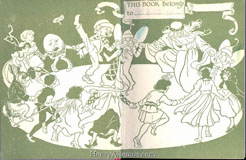
Green
|
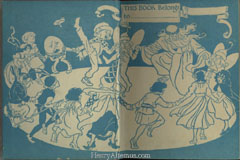
Blue
|
| |
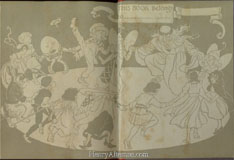
Grey
|

Multicolored
|
- Most of the earliest books in this format which
were published until 1920 had yellow lettering on
their covers. Red lettering was noted on The Night
Before Christmas and Peter Rabbit's Christmas.
Thereafter the familiar black lettering was present
on all the books (new and reprints).
- In the 1930s variant format III books were
published which had a red or orange (not a grey)
cloth cover. They had plain brown endpapers. These
books were advertised as being in a library buckram
cloth and are sewed by the latest method and are
reinforced to give the greatest degree of strength
and durability. These latter books were 75 cents
each while the Wee Books bound in presumably not the
latest method were still 50 cents each.
- Several variant end papers have been seen with the
typical design noted in #6 above but with out any
color. Although it is unclear whether these end
papers are a typographical error or were printed
intentionally by Altemus, they all were published in
the 1928 range.
- A cover variant exists in which the entire front
cover is a paste-on (applique). Based on end papers
and ads these were most likely published between
1928 and 1929. Books from the Wee Books for Wee
Folks Series, Peter Rabbit Series, Little Sallie
Mandy Series, Little Bunnie Bunniekin Series and the
Little Black Sambo Series have been seen in this
style.
- Altemus published ten Wee Folks' Library Sets.
Each set consisted of four Wee Books' titles in a
colorfully illustrated box for $2.25 each. The first
six sets were published in 1921. The next four in
about 1923. These sets as shown below are listed in
the Altemus catalogues into the 1930's.
Here is an example of an early boxed set published
in about 1923. This set is #1 and contains the the
first four Peter Rabbit books. The books have the
blue endpapers and ads that go to Grunty Grunts and
Smiley Smile-Indoors.
There were sets that did not conform to the
catalogue listings. Because these boxed sets are so
rare, a comprehensive listing of the variants is
impossible. Here is a recently discovered example.
The books in the set below have the 1928-1929
variant cover.
Four books are within the box:
1. Old Red Reynard, the Fox
2. Grunty Grunts and Smiley Smile Indoors
3. Hootie Toots Hollow Tree
4. The Robber Kitten
Of interest is that Hootie Toots was published in
1925 -after the ten boxed sets listed below were
produced. Thus there must have been other boxed sets
not described.
A number of the sets were later republished by Platt
and and Munk in three and four book boxes.
See http://www.henryaltemus.com/reprints/platt.html
Set No. 1
Tale of Peter Rabbit
Peter Rabbit at the Farm
Peter Rabbit's Christmas
How Peter Rabbit Went to Sea
Set No. 2
Little Small Red Hen
Little Black Sambo
Three Little Pigs
Night Before Christmas
Set No. 3
Mother Goose Nursery Tales
Mother Goose Nursery Rhymes
Foolish Fox
Robber Kitten
Set No. 4
Little Wise Chicken that Knew it All
Long Ago Years Stories
Piffle's A B C Book of Funny Animals
Four Little Pigs that Didn't Have Any
Mother
Set No. 5
Wee Folks Stories from the Old Testament
Wee Folks Stories from the New Testament
Wee Folks Life of Christ
Wee Folks Bible A B C Book |
Set No. 6
Little Bunnie Bunniekin
Little Mousie Mousiekin
Little Squirrelie Squirreliekin
Old Reynard the Fox
Set No. 7
Peter Rabbit's Easter
When Peter Rabbit Went to School
Peter Rabbit's Birthday
Peter Rabbit Goes a-Visiting
Set No. 8
Peter Rabbit and Jack-the Jumper
Peter Rabbit and Little Boy
Peter Rabbit and Little White Rabbit
Peter Rabbit and Old Witch Woman
Set No. 9
Wonderful Story of Cinderella
Story of Red Riding Hood
Story of the Three Bears
Puss in Boots
Set No. 10
Story of Poor Cock Robin
Three Little Kittens Who Lost Their Way
Chicken Little
Tom Thumb |
|
